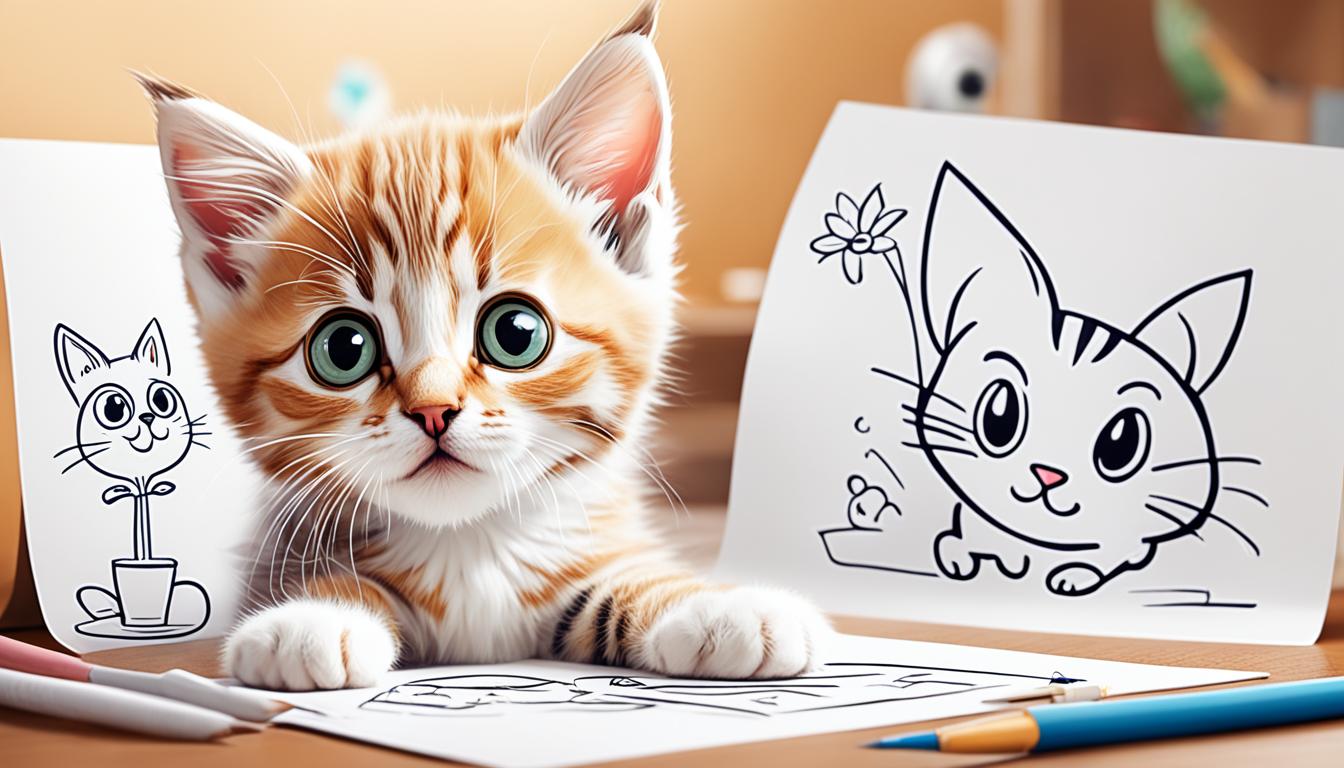How to Draw Cat – Drawing Turorials and Coloring Tips
Have you ever wanted to capture the beauty and elegance of a cat in your drawings? Whether you’re a beginner or an experienced artist, learning how to draw a cat can be a rewarding experience. But where do you start? How do you create realistic fur textures or bring out the expressive eyes?
Join us as we dive into the world of cat drawing. In this article, we will provide step-by-step tutorials, helpful tips, and coloring techniques to help you bring your feline creations to life. From sketching the head and body to adding intricate details, you’ll learn the secrets to creating stunning cat drawings.
So, are you ready to embark on an artistic journey and unlock your cat drawing potential? Let’s get started!
Key Takeaways:
- Learn the step-by-step process of drawing a cat with easy-to-follow tutorials.
- Discover tips and techniques to make your cat drawings realistic and captivating.
- Explore different cat drawing styles and find your unique artistic voice.
- Master the art of coloring and shading to bring your cat drawings to life.
- Share your cat drawings and connect with fellow artists for inspiration and feedback.
Sketching the Cat’s Head and Body
Are you ready to bring your cat drawing to life? In this section, we will guide you through the step-by-step process of sketching the cat’s head and body. Whether you’re a beginner or looking for a refresher, this tutorial is perfect for you. Let’s get started!
Step 1: Head and Body
To begin, sketch a circle for the cat’s head. This will serve as the foundation for your drawing. Next, draw a rectangle below the head to represent the body. Connect the head and body with a curved line to create the neck.
Step 2: Ears and Face
Now it’s time to add the ears and face. Draw two triangles above the head to represent the ears. Next, create a square outline within the head to form the face.
Step 3: Eyes and Nose
Let’s bring the cat to life by adding the eyes and nose. Draw a curved triangle within the face to represent the eye. Then, add a line for the nose, positioning it just below the eye.
Step 4: Legs and Tail
To complete the body, draw ovals for the legs and a curved line for the tail. Position the legs at the bottom of the rectangle, ensuring they are evenly spaced. Connect all the shapes together to create the outline of the cat.
Step 5: Details
Erase any overlapping or unnecessary lines, leaving only the final outline of your cat. Now it’s time to add details! Pay attention to the eyes, ears, and paws. Add small curves and angles to capture the unique features of a cat.
Summary
Congratulations! You’ve successfully sketched the cat’s head and body. Remember to take your time and practice the steps to improve your cat drawing skills. In the next section, we will dive deeper into adding details to the cat’s features, so stay tuned!
Adding Details to the Cat’s Features
Now that you have sketched the basic outline of your cat, it’s time to bring it to life by adding details to its features. These little touches will make your drawing more realistic and captivating. Here are some cat drawing tips and tricks to help you add those finishing touches:
- Refine the Ears: Start by drawing a smaller triangle inside the front ear. This will give the ear a more defined shape and make it look more realistic.
- Bring the Eyes to Life: To make the cat’s eyes shine, mark a small slit for the pupil. This simple detail adds depth and intensity to the drawing.
- Add Claws to the Paws: Draw small curved lines on the paws to create the claws. Pay attention to their placement and size for a more authentic look.
These cat drawing tips and tricks will enhance the overall appearance of your cat drawing and make it stand out. If you prefer a visual guide, you can also explore cat drawing video tutorials online. These tutorials provide step-by-step demonstrations of how to add details to the cat’s features, making it easier for you to follow along and master the techniques.
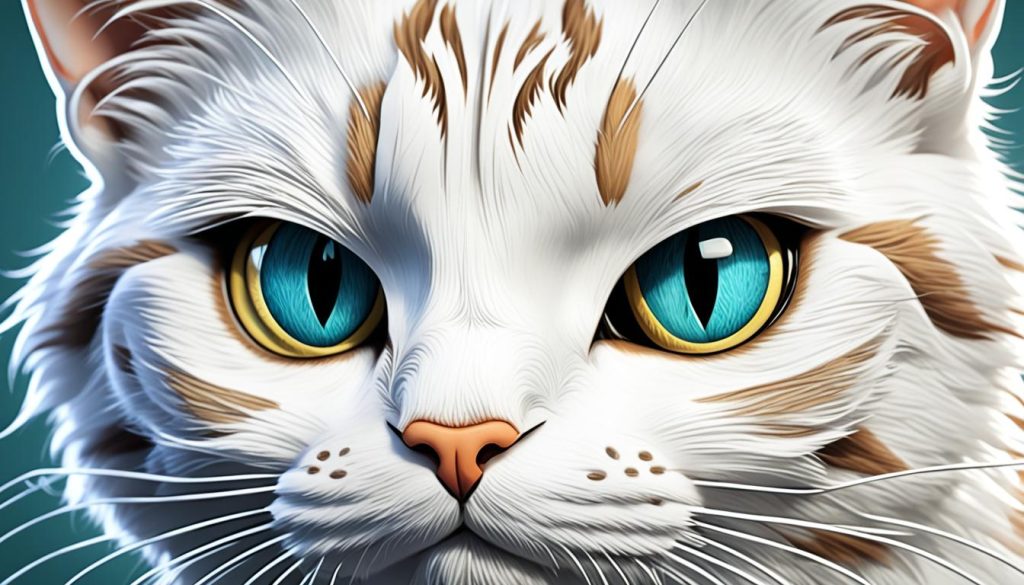
Adding details to your cat’s features elevates your drawing from a simple outline to a visually captivating artwork. These subtle touches bring it to life and make it more enjoyable for viewers. So, take your time, experiment with different techniques, and enjoy the process of adding those final touches to your cat drawing.
Coloring the Cat
Once you’ve finished adding details to your cat drawing, it’s time to bring it to life with colors. Coloring is a fun and creative part of the process, and there are various techniques you can try to make your cat drawing stand out.
You can use different coloring tools such as crayons, markers, colored pencils, or watercolors, depending on your preference and the effect you want to achieve. Experiment with different color palettes to create a unique and vibrant cat drawing that reflects your artistic style.
If you’re using colored pencils, consider using darker colors to shade your drawing and add depth. You can use lighter shades to highlight certain areas and create contrast. Remember to blend colors smoothly to achieve a more realistic and polished look.
For a more whimsical or expressive cat drawing, you can experiment with bold and vibrant colors. Let your imagination run wild and use unconventional color combinations to give your cat a truly distinctive appearance.
This step is a great opportunity for kids to unleash their creativity and have fun with their artwork. Encourage them to explore different coloring techniques and express their own artistic style.
Remember, there are no limits when it comes to coloring your cat drawing. Let your intuition guide you, and don’t be afraid to try new things. The goal is to create a cat drawing that brings joy and captures the essence of feline beauty.
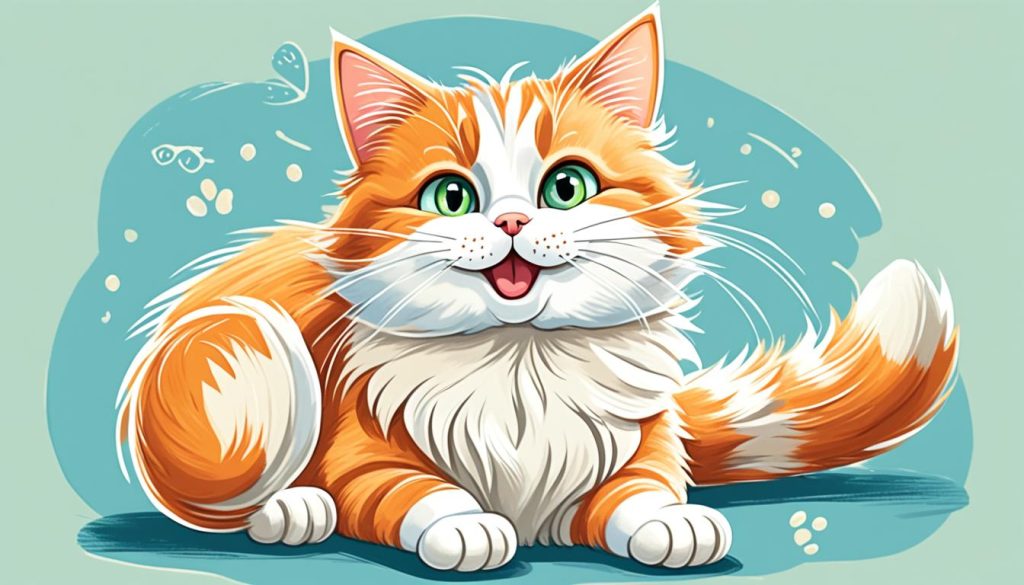
Coloring Tips:
- Start with light colors and gradually build up with darker shades for a smooth transition.
- Experiment with different coloring techniques such as blending, layering, or crosshatching to add depth and texture.
- Use reference photos or real cats as inspiration for color choices and patterns.
- Consider the lighting and environment in your drawing to create a more realistic effect.
- Don’t be afraid to make mistakes. Coloring is a creative process, and sometimes unexpected color choices can lead to beautiful results.
Drawing a Colorful Cosmic Cat
If you’re looking for a more whimsical approach to cat drawing, try creating a colorful cosmic cat. Using colored pencils, markers, or paint, you can draw a cat with psychedelic designs and vibrant colors.
Start by drawing a grid on your paper to help with proportions. Then, follow the step-by-step instructions to draw the cat’s face and body. Once the outline is complete, let your creativity shine by adding colorful designs and patterns to the cat’s fur.

Creating a Simple Cat Drawing
If you’re a beginner in cat drawing and prefer a simpler approach, you can still create a cute and charming cartoon cat. Follow these easy steps to bring your cat drawing to life:
- Start with a small oval for the head.
- Draw a long oval underneath the head for the body.
- Add a curving line to connect the head and body, forming the neck.
- Now, it’s time to draw the cat’s features. Add two small circles for the eyes, a triangle for the nose, and a curved line for the mouth.
- Complete the drawing by adding the legs, paws, and a fluffy tail.
For added detail and texture, use short bold strokes to represent fur. Remember to erase any unnecessary lines to give your cat drawing a clean look.
Here’s an example of what your simple cat drawing could look like:
| Materials | Step-by-Step |
|---|---|
|
|
With these simple steps, you can create a delightful cartoon cat drawing. Let your imagination run wild and enjoy the process of bringing your cat to life on paper!

Adding Details to the Simple Cat Drawing
Now that you have sketched the basic outline of your cat, it’s time to bring it to life by adding details. These small touches make a big difference in creating a more realistic and interesting cat drawing. Follow these step-by-step instructions for adding the essential features of a cat.
1. Draw Ear Hair
Start by adding some fluffy ear hair to your cat’s ears. Use short, curved lines to create a sense of texture and depth. Pay attention to the direction of the hair to make it look more natural. Cats have different types of ear hair, so feel free to experiment with different styles.
2. Define Eyebrows
Create expressive eyebrows for your cat by drawing short, curved lines above each eye. These lines can convey different moods and add character to your drawing. Play around with different eyebrow shapes and angles to achieve the desired expression.
3. Add Whiskers
Whiskers are an iconic feature of cats. Draw long, thin lines extending from the sides of the cat’s nose. These lines should be delicately curved and can vary in length. Remember to leave some space between each whisker and to draw them symmetrically on both sides of the face.
4. Bring the Fur to Life
Using bold, short strokes, add fur lines to your cat’s body. This technique adds texture and depth to the fur, making it appear more realistic. Vary the length and direction of the strokes to create a sense of movement and dimension. Take your time with this step, and don’t be afraid to go back and adjust the strokes as needed.
5. Follow the Step-by-Step Guide
Following a step-by-step guide can help ensure accurate proportions and placement of the cat’s features. Pay attention to the details and take your time to achieve the desired result. If needed, refer back to the earlier sections of this tutorial for a refresher on the basic outline and proportions of a cat.
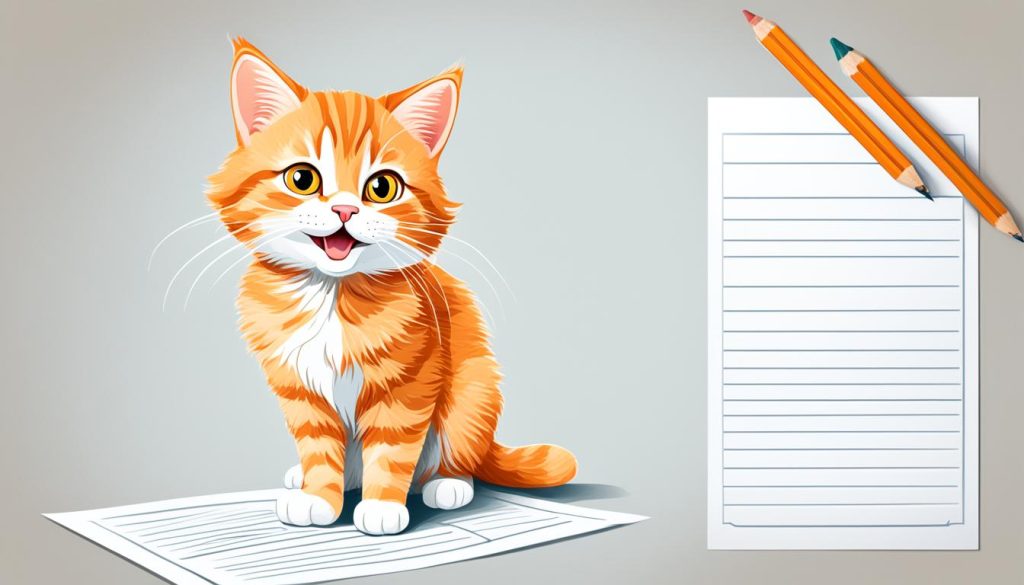
Adding these details will make your simple cat drawing come to life. With ear hair, expressive eyebrows, whiskers, and fur lines, your cat will have a more realistic appearance. Don’t forget to follow the step-by-step instructions and take your time to ensure accuracy and precision in your drawing.
Tips for Drawing and Coloring Cats
Whether you’re drawing a realistic cat or a whimsical cosmic cat, here are some general tips and tricks to help you create stunning feline artwork.
- Start with light lines: Begin your cat drawing with light and loose lines. This will allow you to make adjustments and modifications as you go along.
- Reference photos: Use reference photos of cats to study their anatomy, proportions, and facial features. This will help you capture the essence of a cat in your drawing.
- Practice regularly: Drawing cats regularly will improve your skills and understanding of their unique characteristics. Take time to observe cats in different poses and try sketching them from various angles.
- Layering shades: When coloring your cat drawing, experiment with layering different shades to create depth and dimension. Start with lighter colors and gradually add darker shades to create realistic textures.
- Experiment with techniques and materials: Don’t be afraid to try different drawing techniques and materials to find what works best for you. Explore different pencil strokes, blending methods, and coloring tools to bring your cat drawing to life.
Remember, drawing cats is a skill that can be developed with practice and experimentation. Enjoy the process, embrace your creativity, and let your love for cats shine through in your artwork.

Don’t Miss Out on Expert Advice
Explore online tutorials, video guides, and communities dedicated to cat drawing. These resources offer valuable insights and techniques shared by experienced artists. Engage with fellow cat enthusiasts, seek feedback on your work, and stay motivated on your artistic journey.
Try Different Cat Drawing Styles
Don’t be afraid to explore different cat drawing styles. Whether you’re a beginner or have some experience, experimenting with various techniques can unleash your creativity and help you develop your own unique cat drawing style. From realistic portrayals to whimsical cartoons, the possibilities are endless.
Try playing with proportions, shapes, and features to create your own interpretation of a cat. You can also incorporate different art mediums and styles to add depth and variety to your drawings. Consider using watercolors for a vivid and fluid effect, pen and ink for bold and striking lines, or digital drawing tools for precise and clean illustrations.
The more you practice and experiment, the better you’ll become at capturing the essence of a cat in your drawings. Don’t be discouraged if your first attempts don’t turn out as expected. Each drawing is a learning experience and a step towards finding your own unique style.
Some Styles to Consider:
- Realistic Cat Drawings
- Cartoon Cat Drawings
- Abstract Cat Drawings
- Minimalist Cat Drawings
Realistic cat drawings aim to capture the details and proportions of a cat with precision and accuracy. Pay attention to the shape of the head, the texture of the fur, and the eyes’ expression to create a lifelike drawing.
Cartoon cat drawings simplify the features of a cat into playful and exaggerated forms. Experiment with different facial expressions, body shapes, and dynamic poses to bring your cartoon cat to life.
Abstract cat drawings focus on capturing the essence and energy of a cat rather than its realistic representation. Use bold shapes, vibrant colors, and expressive lines to create an abstract interpretation of a cat.
Minimalist cat drawings strip away unnecessary details and focus on capturing the basic forms and shapes of a cat. Simplicity and negative space play a key role in minimalist drawings.
Examples of Different Cat Drawing Styles:
| Realistic Cat Drawing | Cartoon Cat Drawing |
|---|---|
 |
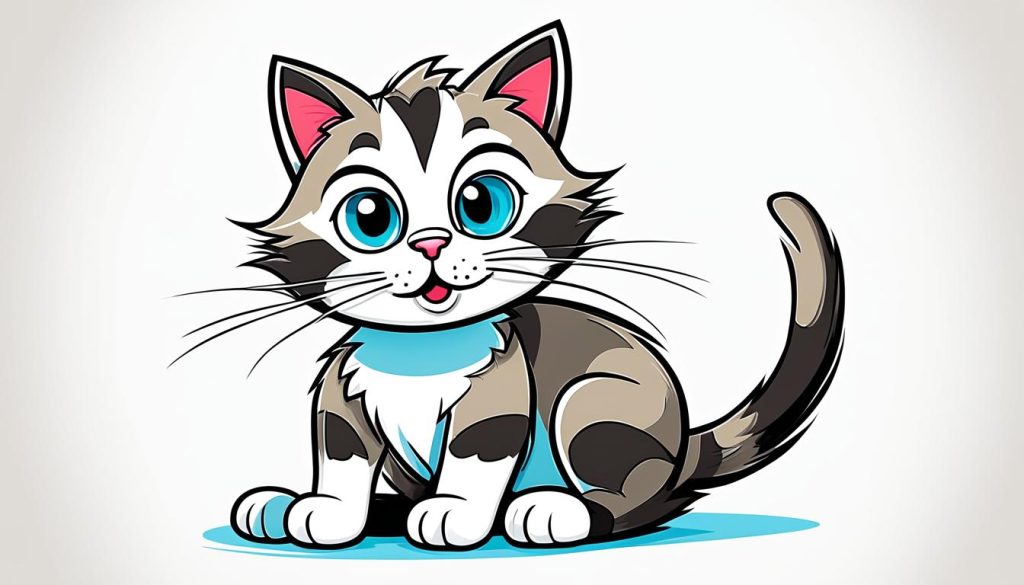 |
Share Your Cat Drawings
Once you’ve created your cat drawings, it’s time to share your artistic creations with the world! Sharing your artwork not only allows you to showcase your skills but also provides an opportunity to connect with fellow cat drawing enthusiasts and receive valuable feedback and inspiration. Here are some ways you can share your cat drawings:
- Post on Social Media: Share your cat drawings on popular social media platforms like Instagram, Facebook, or Twitter. Use relevant hashtags such as #catdrawing or #artshare to reach a wider audience and attract fellow cat lovers.
- Join Art Communities: Become a part of online art communities like DeviantArt or Behance. These platforms provide a space to share your cat drawings, engage with other artists, and discover new art styles and techniques.
- Participate in Challenges or Contests: Look out for drawing challenges or contests related to cat art. Participating in these events can not only motivate you to create more cat drawings but also give you a chance to win prizes and gain recognition for your talent.
Sharing your cat drawings can be a fulfilling experience. It not only allows you to express your creativity but also inspires others to explore their artistic side. So don’t hesitate, share your cat drawings and let your passion for feline art shine!

Conclusion
Drawing cats can be a fun and rewarding artistic endeavor. Whether you’re a beginner or an experienced artist, these tutorials and tips will help you improve your cat drawing skills. By following step-by-step instructions, practicing regularly, and experimenting with different styles and techniques, you can unleash your inner artist and create fantastic feline masterpieces!
From simple sketches that capture the essence of a cat to vibrant cosmic cats that burst with color, there are endless possibilities to explore. Feel free to get creative and add your personal touch to every drawing. Remember, the journey of art is meant to be enjoyable, so have fun with your cat drawings!
Don’t be afraid to try different mediums and styles, such as watercolor, pen and ink, or digital drawing. Each technique brings its own unique beauty to your cat drawings. And don’t forget to share your creations with others! Posting your artwork on social media platforms, joining art communities, and participating in drawing challenges allow you to connect with fellow cat drawing enthusiasts and get valuable feedback and inspiration.
So, grab your sketchbook, tools, and let your imagination soar. With practice, patience, and a passion for drawing, you’ll soon be creating captivating cat illustrations that will make any feline lover purr with delight. Enjoy the journey of discovering your own artistic style and creating remarkable feline artwork!
